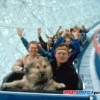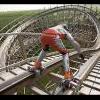RCT Discussion / Mapping NE's artistic movements and trends
-
 04-December 15
04-December 15
-

 Liampie
Offline
I've been thinking about doing this for a while. I want to define all the prominent movements/styles that NE or the RCT community in general has seen, and put them on a timeline. I'm keeping an excel sheet to assist me, but it is not quite ready to show it you guys yet. I'd like some input first.
Liampie
Offline
I've been thinking about doing this for a while. I want to define all the prominent movements/styles that NE or the RCT community in general has seen, and put them on a timeline. I'm keeping an excel sheet to assist me, but it is not quite ready to show it you guys yet. I'd like some input first.
This is what I came up with so far. A lot of these movements are on a continuum, so the later parks of movement A may also fit into early parks of movement B. They may also have characteristics of both. A movement may also split up.
RCT2
Classic NE Style
Description: semi-realistic, excessive theming, focus on aeshetics, slightly randomised textures and details, not rarely pastel colours, thick foliage
Prominent during: 2004-2005
Parkmakers: Early Turtle, John, X250, artist
Examples: Rivers of Babylon (2004), Bijou Magique (2004), Ports of Magia (2005), Islands of Enchantment (2005),Isole Calabria (2005), The Masterpiece (2005), Rapa Nui (2006)
Proto-Realism
Description: focus on aesthetics with stylistic similarities to Classic NE Style, but more down to earth. Less pastel, more grey and brown. Specific look for architecture
Prominent during: 2005-2008
Parkmakers: sloB, egg_head, early Cedarpoint6, Steve, zodiac
Examples: Thrillmatic 2 (2005), Sea World Brisbane (2006), The Black Lagoon (2006), Mountaineer (2007), Silhouette (2008), Indigo Hills (2009)
And that is how modern realism was born. Kayte Ridge got released and after that I recognize two parallel main streams.
Clean Realism (School of Cedarpoint6)
Description: focus on realism over aeshtetics, not rarely themeless. Style is clean and simplified, and slightly more cartoonish than our real world
Prominent during: 2006-current
Parkmakers: Cedarpoint6, Ramsam12, Maverix, Pacificoaster
Examples: Kayte Ridge (2006), Watkins Woods (2007), Woodfall Park (2010), Piraña (2011), Disney's American Waterfront (2012), Starpointe (2013), Paradise Pier (2015)
Hyperrealism (School of geewhzz)
Description: maximum focus on realism, including the imperfections, awkwardness and roughness of real life. Dumpsters everywhere
Prominent during: 2008-2012 (not dead, but it's past its peak)
Parkmakers: geewhzz, RRP, disneylhand, robbie92
Examples: El Encierro (2008), Castle Howard (2008), Belmont Shores (2009), Lenox Mall (2009), Kumba (2010), Six Flags Santa Fe (2011), Thunderclap (2012), Cedar Point's Raptor (2015)
Non-NE movements
Paulism
Description: imitations of Paul 999. Realistic and awkward, but still abstract. A lot of grey and brown, castle texture, pirate roofs, fence gates posing as signs, Efteling influences and timeline parks
Prominent during: 2005-2007
Parkmakers: Paul 999, Sven, anyone at SaveRCT2/RCT-Guide at that time
Examples: Attractiepark Duinenzicht (2005), Resort Heusenhout (2006), Attractiepark Gelderwal (2006), Attractiepark Groezelen (2006), Europapark (~2008?),
LL
I find it hard to define the older LL stuff yet, I need input. The later LL movements are easier, but might still be controversional in how I defined them
Experimental LL
Description: very technical, heavily reliant on Codex
Prominent during: 2007-2012
Parkmakers: Corkscrew, JJ, RMM, Roomie, pierrot, Airtime, ][ntamin22
Examples: Mercury Valley Mills (2007), Nihombasa (2009), Sea World Sydney (2009), Trinity Glades (2010), Pinball Wizard (2010), Portal (2011), Adelaar (2011), The Siege of Jerusalem (2012)
The next two genres might be controversial. They are very much alike, but the difference lies in the approach.
Regressive Traditional LL
Description: nostalgic, imitating old masters, very little experimentation
Prominent during: 2008-now
Parkmakers: Gwazi, Cocoa, Liampie, Poke
Examples: Terra Antico (2008), Pearl Bay (2010), Luscia (2012), Capricorn Coast (2014), Fabritius Delta (2015), Archipelago (2015)
Progressive Traditional LL (if anything, this is the main LL stream that has been going on for 20 years)
Description: nostalgic, but experimental within the conventions of classic LL. More focus on own identity rather than imitating others
Prominent during: 2008-now)
Parkmakers: Loopy, Cocoa, Liampie, Roomie, alex
Examples: Silver Valley Theme Park (2008), Lost Tours (2009), Through the Ages (2011), Escapist Experience (2013), Constantopia (2014), Lake Chronus (2015)
So what's missing? A lot. Some thoughts:
- I think I should split Classic NE Style, to create a 'Vertical NE Style' movement, stuff like A Love Token, Euphoria City and Kurakku, that are a lot more extreme in their looks, with very dramatic depth and elevation. Could include JKay
- I should add an RCTSpace style, although I'm not too familiar with those parks, people like Mama Bear, early Six Frags and Emergo show a lot of similarities deviating from NE norms.
- Classic NCSO: all NCSO used to look the same. Brown and boring
- NCSO-revival: only in recent years NCSO started to mature/develop and winning accolades. Definitely a movement in my opinion, although there aren't too many releases
- I don't know where to put J K. It's not quite like Turtle/artist, but it follows some of the same conventions.
- Same goes for most modern RCT2 stuff that's not one of the realism genres. I guess I could group myself with 5Dave and Cocoa into something like 'Atmospheric Parkmaking' (Canthose, Legacies, Archimedes)
- Where do Kumba, Levis and eyeamthu1 go? -

 G Force
Offline
A few comments: (note this is kind of a mess, probably should of waited to organize my thoughts a little more)
G Force
Offline
A few comments: (note this is kind of a mess, probably should of waited to organize my thoughts a little more)
When it comes to modern RCT2, or post Watkins Woods really. Almost feel you need a third category kind of in between the two you have. Not exactly sure what you would call it, but its almost a interpretive realism, more closely in line with Proto-Realism where on the surface it looks completely believable but it lacks the small realistic details like backstage areas, catwalks, transfer tracks. I'd put parks like Legacies and Zippos in this category. Parks that focus on a realistic aesthetic without all the "ugliness' of real life parks.
I'd also redefine Hyper-Realism slightly to not include SFSF, that park along with a few attempts at chain parks at the time need almost a separate sub-category. These parks while they look like the parks they are trying to mimic at a glance, seem to fall short in terms of approach. SFSF has far to simple of a path layout and is organized way to well to be a real park SF built from scratch, it is also to clean to be considered among things like ThunderClap or Raptor.
Next, as far as old school RCT goes, maybe a "pre-cso" category to help define Wormwood and even Tiled Aches to an extent, parks that used the base game objects fully, before the development of CSO changed the way buildings and aesthetic were approached.
Post-NE Style is a category that could include the works on J K and maybe eyeamuth1 as well. These builders feel as if they were plucked right out of 2004/05 and given modern objects. They have large themed areas with unifying color schemes that completely define their atmosphere. There is also a focus on architecture and the use of newer fences and 1/16th and 1/8th tile objects to create a new aesthetic. Parks like Magic Realms, Spellbrook, and Dreamport would obviously fit in here.
Low-Fantasy and High-Fantasy could be titles used to define Jkay's spotlights and FK's Swoon respectively. These two are fundamentally different but both provide a completely non-believable atmosphere that stretches the mind when one looks at it, almost confusing as much as pleasing. DRC is a park that could slide into this as well, although its almost as much Post-NE as it is Fantasy. Perhaps if we include DRC, Virginia Keys could also fit in here along with Roman Vice.
A lot of this might just be different depths of differentiation between styles, as you could probably group a lot of things together just as easily as completely separate them.
LL is really tough, its almost as if you need a 3rd era for everything pre-RCT2. Maybe at a later time when I can focus my thoughts a bit more I'll make a post on that. One change I'd suggest though, add/include Slime Meridian to the Experimental LL category. Tons of Codex used here, and doesn't really fit in with the classic Fatha' style of BGSS and DMM. -

 posix
Offline
Nice Liam. Remember the topic on styles and approaches. I thought that was more interesting actually and worth continuing.Cassic "NE Style" I think you want to keep separate from RCT2, as the term is really Nevis/x-sector/PyroPenguin LL and all their imitators from 2001 until RCT2. Essentially until Toon. Btw, have you ever seen x-sector's and Pyro's collabo "Project Spiffy"? I think you'd love it. It was the end period of NE Style, when both players had developed it into heavy trackitecture use, but still holding true to their general 2x2ism design language, albeit at highly complex level. Only the entrance exists.RoB is in a league of its own and was never even imitated by anyone, I don't think. I really don't see it fit in "Classic NE Style", apart from the terminology issue.I really like your two schools of CP6 and geewhzz. This was the time when you'd fully arrived in the community, so you know this best.For LL, interesting post-modern perspective. I think what Coaster Ed busted out for the H2H seasons he was in changed the way people saw LL. Then darkfire released codex and there was no stopping. But LL died, and the resurged in recent years. The king of this time being pierrot.
posix
Offline
Nice Liam. Remember the topic on styles and approaches. I thought that was more interesting actually and worth continuing.Cassic "NE Style" I think you want to keep separate from RCT2, as the term is really Nevis/x-sector/PyroPenguin LL and all their imitators from 2001 until RCT2. Essentially until Toon. Btw, have you ever seen x-sector's and Pyro's collabo "Project Spiffy"? I think you'd love it. It was the end period of NE Style, when both players had developed it into heavy trackitecture use, but still holding true to their general 2x2ism design language, albeit at highly complex level. Only the entrance exists.RoB is in a league of its own and was never even imitated by anyone, I don't think. I really don't see it fit in "Classic NE Style", apart from the terminology issue.I really like your two schools of CP6 and geewhzz. This was the time when you'd fully arrived in the community, so you know this best.For LL, interesting post-modern perspective. I think what Coaster Ed busted out for the H2H seasons he was in changed the way people saw LL. Then darkfire released codex and there was no stopping. But LL died, and the resurged in recent years. The king of this time being pierrot. -

 Tolsimir
Offline
To answer your last questions. I think it's not possible to pigeon-hole each player in terms of style. I mean some people like Kumba have a clear unique style (maybe his recent realism approaches apart)and you will always guess his contribution correctly. And that is maybe a great thing for a player to have his own style and for some reason people not even trying to copy it. For Kumba (drc, roman vice, his micros) I dont know of any people who actually tried to adapt this style like we have seen in these "schools" you mentioned. and this isnt because of Kumba's work being shit, his parks were highly appreciated. Same goes for Levis imo. You should see some guys as standalones with their individual styles.
Tolsimir
Offline
To answer your last questions. I think it's not possible to pigeon-hole each player in terms of style. I mean some people like Kumba have a clear unique style (maybe his recent realism approaches apart)and you will always guess his contribution correctly. And that is maybe a great thing for a player to have his own style and for some reason people not even trying to copy it. For Kumba (drc, roman vice, his micros) I dont know of any people who actually tried to adapt this style like we have seen in these "schools" you mentioned. and this isnt because of Kumba's work being shit, his parks were highly appreciated. Same goes for Levis imo. You should see some guys as standalones with their individual styles.
It's rather interesting that these individual styles are more present in fantasy parkmaking, which I wouldnt call a 'style' itself, more an approach. Fantasy gives the players a larger frame where they can develop their unique style, because players dont have to watch for rules. In hyper realism on the other hand, the general approach demands so many things like catwalks, backlot, undergound canals and all the boring stuff that the end results of different parkmakers lead into much more sameyness, which is later then considered as 'style'. -

 Poke
Offline
Poke
Offline
I don't know why people presume that because I build in LL like the old masters, I'm in any way trying to imitate them. I built that way as it's how I liked to play. Yeah, I would have had to look at older parks in order to learn the style but I'm not trying to imitate them - I just don't really care about micro details and stuff like that.
-

 RCT2day
Offline
RCT2day
Offline
- NCSO-revival: only in recent years NCSO started to mature/develop and winning accolades. Definitely a movement in my opinion, although there aren't too many releases
Oh, Liam. So innocent, so unaware of the prowlings of the underground NCSO community.
-

 Milo
Offline
Milo
Offline
I think Coaster Ed's H2H style and codex created an LL Literalism style where there are builders who felt like there is now no substitution and no excuse for creating ideas as seen in their heads. Instead of a couple corkscrews being called "statue" or "sign" people were trying to actually spell out words or designs as exactly as possible. Architecture within the game got more complex, as well as texture use and a sort of codex modernism style evolved from building with that mindset. I'd say Ed started it, pierrot, me, and Loopy (off and on) carried it to an extreme.
 Tags
Tags
- No Tags
![][ntamin22%s's Photo](https://www.nedesigns.com/uploads/profile/photo-thumb-221.png?_r=1520300638)
